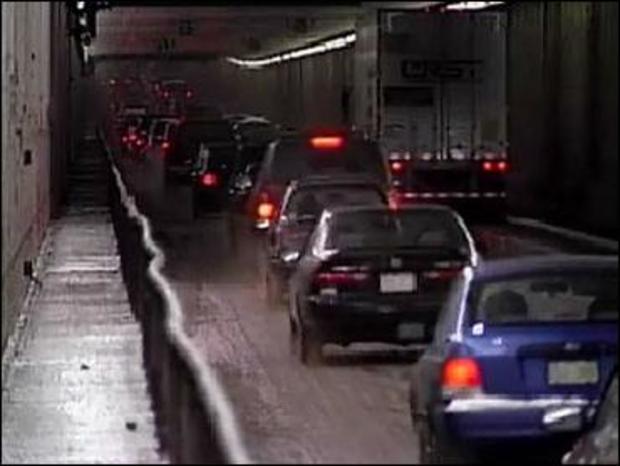Longtime Eisenhower Tunnel Superintendent Retires
FRISCO, Colo. (AP) - Every day at least 45,000 vehicles approach a pair of gaping holes puncturing through the stony heart of the Continental Divide.
At more than 11,000 feet above sea level the world closes in to a symmetrical tranquility of blurred tiles and fluorescent lights.
The average traveler passing through the Eisenhower/Johnson Memorial Tunnel on U.S. Interstate Highway 70 probably doesn't realize a small village of Colorado Department of Transportation workers constantly monitor everything from behind the scenes. It's also one of the safest 1.69 miles of interstate highway in the nation. In operation now for 41 years, there has never been a fatality recorded since it opened to the public. The primary reason for the impeccable safety record was the efforts of Mike Salamon.
"We've had over 300 million vehicles go through that tunnel," Salamon said. "And we've never had a fatality. That's not luck. That speaks to the vigilance of the employees up there and their professionalism.
"I think it's probably one of the safest 2 miles of road in Colorado because of the emphasis we have on safety and monitoring the traffic."
Salamon, 62, of Silverthorne, retired last month after serving as tunnel superintendent for the last 22 years. And during his nearly 40 years at the tunnel at the top of the world, safety was always his primary concern.
"He embraced everything about safety," said current tunnel supervisor John Wilson. He worked with Salamon at the tunnel since the mid-1970s. "He made sure everybody who worked at the tunnel received a lot of safety training. He was instrumental in having all employees receive fire academy training as well."
Behind Salamon's intent, wise eyes, his sharp mind instinctively recalls detailed tunnel statistics. It's no problem for him to rattle off the exact number of fluorescent lights lining the tunnel or the amount of surveillance cameras scattered inside and out.
"The facility is very unique," Salamon said. "It's one of the longest tunnels in the United States and the highest vehicular tunnel in the world."
The steep grades, the extreme weather and the remoteness also set the tunnel apart from all others. It requires the facility and its 50 employees to be nearly self-sustaining.
"Because of the remoteness we've had to be very self-reliant, even in the areas of fire response," Salamon said. "We have a joint relationship with Lake Dillon (Fire-Rescue), but you can imagine if it's a busy day and we've got traffic stopped because we have a fire in the tunnel, it might take a fire department a long time to get to us. So we've always trained our own folk in fire response. And we've invested a lot of money into pretty good fire equipment."
The primary piece is a pumper that can be operated by one person if need be.
Besides firefighters, the tunnel has its own tow trucks, high-voltage systems, computer systems, its own water treatment plant and more than 100 surveillance cameras in and around the facility.
"We're not reliant on anybody to come up and take care of us," Salamon said. "We maintain all the systems. It takes a hardy, dedicated person to work up there."
Those systems include a 150,000-gallon underground reservoir for drinking water and firefighting.
Three crosscuts connect the two tunnels. In the event of fire and heavy smoke people can use the crosscuts to get into the other tunnel. Red strobe lights identify their location, if needed.
He's seen them needed only a few times when smoke from vehicle fires became too thick in one of the tunnels.
"The video surveillance is probably the most important feature from a safety perspective. We can see any event that occurs and respond immediately," Salamon said. "Usually we can get them out of there in a matter of two to three minutes."
The quick response has been tantamount to maintaining such a good safety record.
When Salamon took the job with CDOT in the mid-1970s, he never imagined he'd spend the rest of his professional life there.
"I thought at first it'd be a nice job for about five years, and then I'll move on," Salamon said. "But I fell in love with the job. It's very rewarding. There's a new challenge every day. You're able to help people every day. That's the part I enjoyed the most. You could see the results of your efforts every day. There was always somebody lost or broke down."
And then there were some drivers who suffered from a fear of claustrophobia after entering the tunnel.
"They'd drive into the tunnel, panic and just shut their car off," he said. "We'd have to send somebody in there to drive their car out of the tunnel for them."
The dilemma of eastbound traffic jams on Sunday afternoons has been an issue for decades. The tunnel crew has implemented various techniques to try to combat the tunnel jams.
"For about 10 years, from 1990 to 1999, we'd do reversible lanes in the tunnel," Salamon said. "On Sunday we'd put three lanes eastbound. It was a complicated reroute. But eventually the westbound volumes became so high we couldn't do it anymore because it started backing up westbound traffic as well. But it was an innovative technique that helped alleviate a lot of traffic for years."
The traffic issues predate the tunnel's existence.
"Traffic backups and delays were an issue before the tunnel," he added. "When the only route was Loveland Pass it wouldn't be uncommon to have three-hour delays returning to Denver."
And it's going to continue being an issue.
"There's a tremendous effort to modify people's behavior," Salamon said. "One way is the aggressive signage everywhere. They are also considering opening the shoulders up in some areas."
Widening the tunnel itself would require the creation of a third bore. A study found the project would cost at least $1 billion.
"And if you widen the tunnel - you'd have to widen the lanes leading up to it," Salamon said. "It would require a tremendous effort. I don't see it happening anytime soon."
Salamon has worked at the tunnel almost the entire time it's been open. He's raised three daughters who graduated from Summit High School and now have successful careers of their own.
The town he lives in traces its beginnings to the boring of the tunnels. The miners, who precariously blasted their way through the nearly impenetrable rock to create the highest tunnel in the world, created settlements in what would eventually become Silverthorne. Seven of those miners died during the dangerous process. The now-westbound Eisenhower tunnel opened in 1973. Six years later the eastbound Johnson tunnel was completed.
"It was almost like going to moon for miners back then - working at that high altitude in those extreme temperatures," Salamon said. "At the time it was the most expensive federal highway project in the country."
Construction required 1,500 workers using dynamite to blast through the rock. The first bore doubled the estimated budget.
"They ran into real bad rock, and they had to go to a very labor-intensive form of tunneling called multi-drifts," Salamon said. "Essentially they reinforce the mountain with solid concrete in those bad areas, called the Loveland Fault.
"The engineer who built the tunnel told me if there's an earthquake in Colorado the place he'd like to be is in the middle of the Eisenhower tunnel. I don't know if that's true or not."
The tunnel was funded 90 percent by the federal government and 10 percent by the state of Colorado. In return, the tunnel would be 100 percent maintained and operated by the state. It was obviously a tremendous boon for travel and leisure in the High Rockies. The opening of the tunnel lifted the floodgates into the High Country, allowing easier and quicker access to old mining towns, some of which, like Breckenridge, transformed into wealthy resort powerhouses. It also allowed for the creation of high-scale resort villages like Vail.
The extra volume of tourism into the High Rockies created an almost incalculable windfall of tax revenue for the state and local governments, not to mention large-scale job creation and developments that continue to grow today.
"I think it's the lifeblood to Summit County and Western Slope," Salamon said. "We see 45,000 vehicles go through a day on the weekend. No way Loveland Pass could have ever handled those totals. In the 37 years I've been here I've seen the numbers continue to grow."
One of the hardest parts of retirement for Salamon was leaving behind co-workers who'd become friends.
"We've had a very close-knit workforce over the years," Salamon said. "We have a lot of people that have been there for many years. It's been a great job."
Wilson said when Salamon retired it was the largest gathering he'd ever seen to say goodbye to a CDOT employee.
But the safety measures and best practices Salamon helped put in place will continue to protect the lives of travelers passing through the tunnel at the top of the world.
- By BRANDON DAVIS, Summit Daily News
(© Copyright 2014 The Associated Press. All Rights Reserved. This material may not be published, broadcast, rewritten or redistributed.)




